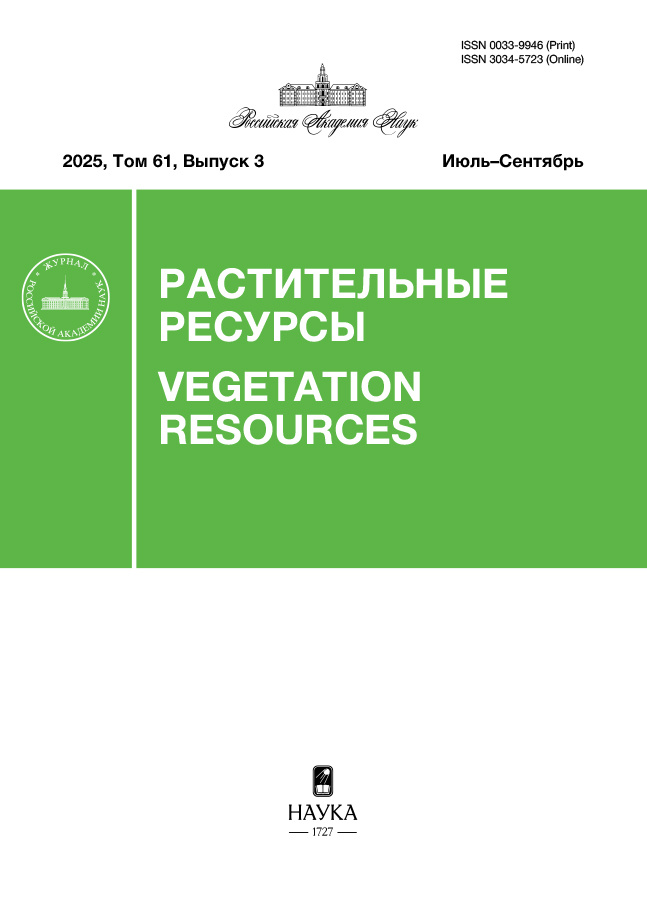Development and Validation of the Method for the Quantification of Hydroxycinnamic Acids in Agastache rugosa (Lamiaceae) Herb
- Authors: Kurdyukov E.E.1, Mitishev A.V.1, Vodopyanova O.A.1, Glebova N.N.1, Selezneva Y.A.1
-
Affiliations:
- Penza State University
- Issue: Vol 61, No 3 (2025)
- Pages: 119-126
- Section: Methods of investigation
- URL: https://cijournal.ru/0033-9946/article/view/695436
- DOI: https://doi.org/10.7868/S3034572325030092
- EDN: https://elibrary.ru/ygwvrq
- ID: 695436
Cite item
Abstract
Korean mint or wrinkled giant hyssop (Agastache rugosa L.) is one of the promising plant sources for the production of medicinal herbal preparations. In this work a technique that has been developed for the quantitative determination of the amount of hydroxycinnamic acids in the herb of A. rugosa by direct spectrophotometry is described. The analytical maxima of the studied compounds are 330 nm and the shoulder is 290 nm. The optimal conditions for the extraction of hydroxycinnamic acids from A. rugosa raw materials are substantiated. Chlorogenic acid was chosen as a reference sample for calculating the content of hydroxycinnamic acids. The developed method is evaluated according to the validation characteristics: specificity, linearity, precision, correctness and is found suitable for use in analytical purposes. It was revealed that the content of hydroxycinnamic acids in the herb of A. rugosa is 7.50 % of the weight of absolute dry raw materials.
About the authors
E. E. Kurdyukov
Penza State University
Email: e.e.kurdyukov@mail.ru
Penza, Russia
A. V. Mitishev
Penza State University
Email: e.e.kurdyukov@mail.ru
Penza, Russia
O. A. Vodopyanova
Penza State University
Email: e.e.kurdyukov@mail.ru
Penza, Russia
N. N. Glebova
Penza State University
Email: e.e.kurdyukov@mail.ru
Penza, Russia
Yu. A. Selezneva
Penza State University
Author for correspondence.
Email: e.e.kurdyukov@mail.ru
Penza, Russia
References
- Fig. 1. Electronic spectra of the standard sample of chlorogenic acid (1) and extracts from the aboveground parts of Agastache rugosa L. (2)
- Kurkin V. A., Avdeeva E. V., Zapesochnaya G. G., Yezhkov V. N. 2005. [Phenylpropanoids of medicinal plants: a monograph]. Samara. 126 p. (In Russian)
- Kurkin V. A., Varina N. R., Avdeeva E. V., Ruzaeva I. V. 2023. Phenylpropanoids as a class of natural biologically active organo-protective compounds. — Pharmacy and Pharmacology. 11(5): 399—411. https://doi.org/10.19163/2307-9266-2023-11-5-399-411 (In Russian)
- Zapesochnaya G. G., Kurkin V. A., Boiko V. P., Kolkhir V. K. 1995. Phenylpropanoids are promising biologically active substances from medicinal plants. — Pharmaceutical Chemistry Journal. 29(4): 277—280. https://doi.org/10.1007/BF02219555
- Kurkin V. A. 2003. Phenylpropanoids of medicinal plants: distribution, classification, structural analysis, and biological activity. — Chem. Nat. Compd. 39(2): 123—153. https://doi.org/10.1023/A:1024876810579
- Kurkin V. A., Dubishchev A. V., Ezhkov V. N., Titova I. N. 2007. Anxiolytic activity of some phytopreparations and phenylpropanoids. — Rastitelnye Resursy. 43(3): 130—139. (In Russian)
- Nechita M. A., Toiu A., Benedec D., Hanganu D., Ielciu I., Oniga O., Nechita V. I., Oniga I. 2023. Agastache species: a comprehensive review on phytochemical composition and therapeutic properties. — Plants. 12(16): 2937. https://doi.org/10.3390/plants12162937
- Bielecka M., Zielińska S., Pencakowski B., Stafiniak M., Ślusarczyk S., Prescha A., Matkowski A. 2019. Age-related variation of polyphenol content and expression of phenylpropanoid biosynthetic genes in Agastache rugosa. — Ind. Crops Prod. 141: 111743. https://doi.org/10.1016/j.indcrop.2019.111743
- Kurkin V. A., Avdeeva E. V. 2009. Problems in standardization of raw plant materials and medicines containing phenylpropanoids. — Pharmaciya (Pharmacy). 1: 51—54. https://elibrary.ru/jwwmrh (In Russian)
- Bubenchikova V. N., Boeva S. A. 2013. Development and validation of methods of quantitative determination of hydroxycinnamic acids in the grass Galinsoga parviflora. — Belgorod State University Scientific Bulletin. Series: Medicine. Pharmacy. 25—1(168): 80—85. https://www.elibrary.ru/sgswsh (In Russian)
- Kurdyukov E. E., Vodop’yanova O. A., Mitishev A. V., Moiseev Ya. P., Semenova E. F. 2020. Method of quantifying the amount of phenylpropanoids in stevia raw materials. — Khimiya Rastitel’nogo Syr’ya. 3: 115—121. https://doi.org/10.14258/jcprm.2020037141 (In Russian)
- Maslovskaya E. A., Sushchenko A. O., Kompantseva E. V. 2024. Determination of hydroxycinnamic acids amount in dandelion officinalis roots of (Taraxacum officinale Wigg), growing in territory of the Stavropol Region. — Proceedings of Voronezh State University. Series: Chemistry. Biology. Pharmacy. 2: 104—111. https://www.elibrary.ru/iuvakl (In Russian)
- Ermakova V. Yu., Nesterova O. V., Kondrashov S. V., Matveenko V. N. 2021. Development of methods for identification and quantitative determination of hydroxy acids in the fruits of Vaccinium oxycoccus L. and Vaccinium macrocarpon Ait. — Bulletin of Moscow University. Series 2: Chemistry. 62(1): 49—53. https://elibrary.ru/zbfpsv (In Russian)
- Kurdyukov E. E., Mitishev A. V., Vodop’yanova O. A., Antropova N. V., Suhanova A. V. 2021. Method for quantitative determination the amount of phenylpropanoids in moringa raw materials. — Vestnik Smolenskoy Gosudarsyvennoy Medicinskoy Akademii. 20(1): 168—174. https://doi.org/10.37903/vsgma.2021.1.25 (In Russian)
- [The state pharmacopoeia of the Russian Federation XV-th edition]. 2023. Vol. 1. Moscow. 1814 p. https://docs.rucml.ru/feml/pharma/v15/vol1/ (In Russian)
- а. [GPM.1.5.3.00012. Determination of the humidity of the medicinal plant raw materials and herbal medicines]. — In: [The state pharmacopoeia of the Russian Federation XV-th edition]. 2023. Vol. 1. Moscow. P. 3069—3071. https://pharmacopoeia.regmed.ru/pharmacopoeia/izdanie-15/1/1-5/1-5-1/opredelenie-vlazhnosti-lekarstvennogo-rastitelnogo-syrya-i-lekarstvennykh-sredstv-rastitelnogo-prois/ (In Russian)
- b. [GPM.1.1.0012. Validation of analytical methods]. — In: [The state pharmacopoeia of the Russian Federation XV-th edition]. 2023. Vol. 1. Moscow. P. 220—234. https://pharmacopoeia.regmed.ru/pharmacopoeia/izdanie-15/1/1-1/validatsiya-analiticheskikh-metodik/ (In Russian)
- Svetikiene D., Zamokas G., Jokubaite M., Marksa M., Ivanauskas L., Babickaite L., Ramanauskiene K. 2024. The comparative study of the antioxidant and antibacterial effects of propolis extracts in veterinary medicine. — Veterinary Sciences. 11(8): 375. https://doi.org/10.3390/vetsci11080375
- Kang S., Lee N., Jung B., Jeong H., Moon C., Park S.-I., Yun S., Yim T., Oh J. M., Kim J.-W., Song J. H., Chae S., Kim J. S. 2024. Anti-amnesic effect of Agastache rugosa on scopolamine-induced memory impairment in mice. — Pharmaceuticals. 17(9): 1173. https://doi.org/10.3390/ph17091173
- Nam H. H., Kim J. S., Lee J., Seo Y. H., Kim H. S., Ryu S. M., Choi G., Moon B. C., Lee A. Y. 2020. Pharmacological effects of Agastache rugosa against gastritis using a network pharmacology approach. — Biomolecules. 10: 1298. https://doi.org/10.3390/biom10091298
Supplementary files










